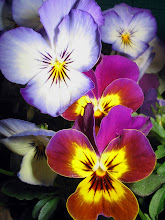 No, sorry, I just can’t review a book named after some of my favourite Bach keyboard music and then call it a day without adding my six ha’pence-worth about the music itself.
No, sorry, I just can’t review a book named after some of my favourite Bach keyboard music and then call it a day without adding my six ha’pence-worth about the music itself.It is, of course, quite impossible to describe music in words. Or at least, it’s impossible for the average reader to ‘hear’ the music described in a novel if they’ve never heard it before. Yet many writers use music to enhance, illustrate or accompany a novel.
Where would Inspector John Rebus be without his rambling record collection, from which he can always find something suitably dark and obscure to reflect his mood?
Martin Edwards takes each of his Harry Devlin novels’ titles from songs which give significant clues to the themes of his books.
Ian McEwan’s evocation of Angela Hewitt’s playing the Goldberg Variations (his protagonist’s background music of choice when performing neural surgery) and his analysis of blues guitar in Saturday struck me powerfully when I first read the book (twice over) and have stuck in my memory. Just thinking about his writing about music makes me want to read the whole brilliant book again.
These are just three examples which spring immediately to my late-night, wine-blurred mind – because they happen to be authors who feature on my 'recently read' pile. There are undoubtedly hundreds of other books with which I could illustrate my theme for this evening: Music Can Enhance a Novel Hugely.
 And now here comes William Coles, who has hung the whole of his first, very readable, novel on the peg – or the whole row of pegs, like a school cloakroom – of Bach’s Well-Tempered Clavier (aka 'Bach's 48').
And now here comes William Coles, who has hung the whole of his first, very readable, novel on the peg – or the whole row of pegs, like a school cloakroom – of Bach’s Well-Tempered Clavier (aka 'Bach's 48').As I mentioned in my previous post - Coles gives us plenty of hints to suggest that he really, really wants his readers to listen to the music which swirls around his story, both literally – the plot itself hinges on a couple of the Preludes - and more subtly, as ambient music.
Reading Coles' book has inspired me not only to listen more carefully and frequently to the Bach piano music which sits, ever ready, in my PC’s iTunes Library, but also (far more amazingly) to dig out the ancient, yellowing copy of Prelude Number One in C Major (aka the easy-peasy Ave Maria one that everyone knows) from my box of long-neglected piano music. I don’t think I learned this for an exam, but I certainly used to be able to play it once upon a time - though my fingers would argue with me on that point. As a severely lapsed pianist, I shall have to take my chances when the house is empty and see what I can make of it. There will probably be tears. But thank you, William, anyway. I'm sure it will all be worth it in the end.
For those who, like Kim in the novel, are Well-Tempered Clavier virgins, I can very highly recommend Angela Hewitt’s interpretation – now available in a new boxed set recording, of which BBC Music Magazine said:
Hewitt has set a new benchmark. Her touch is admirably clear and light ... and she is uniquely attuned to Bach’s supple, sprightly rhythms. A ‘48’ of exceptional grace and beauty. I know of no musician whose Bach playing on any instrument is of greater subtlety, beauty of tone, persuasiveness of judgement or instrumental command than Hewitt’s is here.
You can watch Hewitt playing Book II, Prelude in F sharp minor; and Prelude and Fugue 16 in G minor .
For those who, like Kim in the novel, are Well-Tempered Clavier virgins, I can very highly recommend Angela Hewitt’s interpretation – now available in a new boxed set recording, of which BBC Music Magazine said:
Hewitt has set a new benchmark. Her touch is admirably clear and light ... and she is uniquely attuned to Bach’s supple, sprightly rhythms. A ‘48’ of exceptional grace and beauty. I know of no musician whose Bach playing on any instrument is of greater subtlety, beauty of tone, persuasiveness of judgement or instrumental command than Hewitt’s is here.
You can watch Hewitt playing Book II, Prelude in F sharp minor; and Prelude and Fugue 16 in G minor .

There’s also the incomparable Glenn Gould, of course – of whom I’m a fan, though his playing (and sometimes audible singing along and other quirks) does not suit some contemporary tastes. He recorded this set in the 1960s. Do see the excellent review (the first one on the page link above) by Amazon Top 50 Reviewer David Bryson, with whose assessment I fully concur. He concludes:
I go further than just recommending this set to all lovers of Bach, I would say that whatever other accounts you may own you should not be without this one . . . This is Bach's 48, it contains some of the greatest music ever put on paper, it deserves and cries out for genius in its interpretation, and you will find that in a particularly undiluted form here.
If you’ve never watched Gould playing (and singing), do take a look at this.
Finally, and rather wonderfully, here’s a picture of Hewitt and Gould together (sort of) which I nicked from Angela’s blog (hope she won't mind), and which was taken on her ambitous, 14-month Bach World Tour .
Finally, and rather wonderfully, here’s a picture of Hewitt and Gould together (sort of) which I nicked from Angela’s blog (hope she won't mind), and which was taken on her ambitous, 14-month Bach World Tour .























2 comments:
Two great posts, thank you. I love my Angela Hewitt Bach but I am not moved by Glen Gould. I don't know why this is, it is not because of the singing along. I think it may be because it is the personality of the player that dominates my listening telling me what he hears Bach saying rather than letting the music speak to me about Bach which I get from Hewitt. Have you heard the John Eliot Gardiner Bach Cantatas, a year long musical pilgrimage performed by the Monteverdi Choir and the English Baroque Soloists? They are in the most beautifully designed covers with haunting portraits of Eastern peoples.
Yo what about Rosalyn Tureck's take on WTC? I haven't found one I enjoy more
Post a Comment